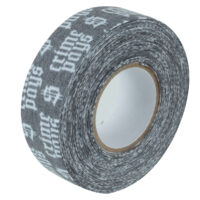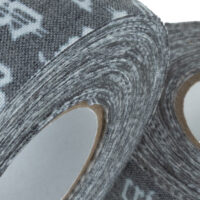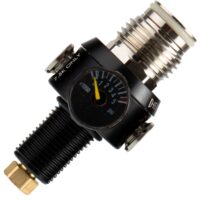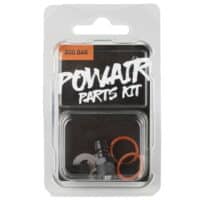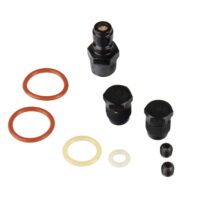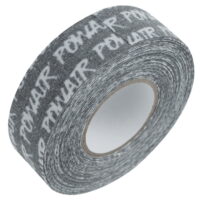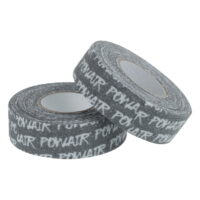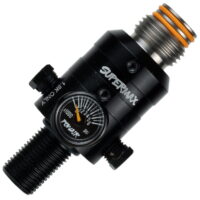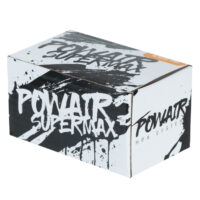Paintball HP systems
300 bar full power for your marker. The most important accessory for every paintball marker is the HP system , because without a reasonable and constant air supply, even the best model only works half as well.
In general, a distinction is made between the simple HP systems made of aluminum and the more complex, but also more expensive composite bottles made of fiberglass or carbon fiber.
As the name suggests, the aluminum air systems have a simple but stable aluminum bottle and are therefore generally somewhat heavier than composite bottles. The biggest advantage of these systems is clearly the price. You get such an HP system for about a third of the price that you would otherwise have to pay for a composite system. On the other hand, these bottles are almost twice as heavy as composite bottles of the same size. It should also be noted that the aluminum bottles can almost exclusively be filled with a filling pressure of only 200 bar. They are not suitable for operation with 300 bar filling pressure.
The composite systems are completely different in their processing. Here a core, which is usually made of plastic or aluminum, is covered with a mesh made of carbon fiber or fiberglass and then sealed with very hard and durable synthetic resin. This construction of several layers of ultra-light material makes the paintball composite HP systems significantly lighter and more stable than comparable aluminum models. The bottles can easily be filled on the field with a pressure of up to 300 bar and thus offer a significantly larger air reserve.
With HP systems, size and weight are decisive
Modern paintball HP systems , also called air systems or preset systems, are made of light and very durable materials such as aluminum, glass and carbon fiber and a synthetic resin coating. This gives the bottles a very high level of stability and reduces the weight to an absolute minimum. Whereas comparable air systems weighed a good 1.5 to 2 kilograms a few years ago, today you can already get bottles that only weigh around 600 to 700 grams. While this difference may seem small and perhaps negligible for the rental market, these technical innovations and weight savings are a real boon for the professional paintball player. The weight of the equipment is significantly reduced by the much lighter systems. This also has a huge impact on marker handling, as the player is much more agile with a light HP bottle than with a bulky, heavy bottle.
How long does my bottle have TÜV?
In general, there are several points of reference on the subject of TÜV for HP bottles. A bottle always has a production date and a final date. The date of manufacture provides information about the month and year in which the bottle was produced. To give an example, 01/2014 would correspond to a bottle produced in the month of January 2014.
The final date, or expiry date of the bottle, records the date on which use of the bottle must be finally discontinued. Depending on the type and material, HP bottles have a total service life of 5 to 25 years.
An aluminum bottle, for example, always has a shelf life of 10 years from the date of manufacture. If you now want to know how long the bottle can be played until it has to be checked, you simply take the date of manufacture and add 10 years to it. The special thing about aluminum bottles is that they have practically no expiration date. So the player can extend the TÜV every 10 years for another 10 years. However, it should be noted that refilling a bottle is usually almost as expensive as a new bottle, since the prices for HP systems have fallen sharply in recent years. We therefore recommend simply purchasing a new one after 10 years for such simple aluminum bottles.
With composite bottles it is quite different, they only have 5 years TÜV after the date of manufacture before they have to be tested again. It is also important to note that models with a plastic core, for example, cannot be checked at all. Although these bottles are particularly light and therefore very popular, their approval expires after 5 years and the Paintball HP bottles may no longer be used.
The expiry date can also vary greatly with Composite HP systems, so there are bottles that have a total lifespan of ten, fifteen or even twenty years, depending on the manufacturer.
What do I have to consider for safety with paintball HP systems?
The most important things to note would be that the bottle always has a TÜV mark, in this case a PI mark from the European TÜV, as is common with paintball bottles in the EU and thus also in Germany. Any sane paintball retailer will only offer tested bottles, so you don't need to worry. But control doesn't hurt either.
Furthermore, you should of course make sure that the bottle still has a valid TÜV, i.e. has not already expired or has to be checked.
The last thing to watch out for is the regulator. There is no prescribed test standard for the Paintball HP Regulator , i.e. it does not have to have a TÜV seal or anything similar. Since most brand regulators come from the USA anyway and have the DOT standard there, they have the necessary standard, but still no European TÜV on paper. An alternative is offered by regulators, which, like the bottle itself, have a PI test. European paintball manufacturers are now taking the trouble to subject their regulators to this test procedure for quality assurance. You can recognize the regulators by the stamped PI symbol.
Unfortunately, there are always manufacturers and suppliers who save in the wrong place and import and sell cheap regulators without the necessary quality standards. The customer can save a few euros here, but in the end usually only hassle and running around with his HP bottle.
We therefore generally recommend our customers to buy a proven branded product that comes from at least one of the big, well-known US manufacturers, or a PI-tested regulator from Europe. You will look in vain for anything else with us, because safety comes first with us!
How many shots can I make with the filling of an HP system?
In general, when it comes to the question of air consumption or the number of shots that can be made with a bottle filling, the material used is very important. All sorts of factors play a role here, e.g. the HP system and its filling pressure, the volume of the bottle, the paintball marker and its operating principle and of course the set shooting speed (FPS number).
We just want to explain it using a standard example. For this we take a Tippmann 98 marker & comparable blowback markers like Spyder and clones.
The Tippmann 98 is known to most players and is therefore a very good reference. With a 0.8 liter aluminum HP system with 200 bar inflation pressure, this marker manages around 400-500 shots, depending on the temperature and the FPS set. If you now use a 1.1 liter HP bottle with 300 bar filling pressure on the same model, the number of shots that can be fired is around 900 to 1200. Again, this depends on external influences such as temperature, weather and of course the FPS Number. With a Compostie HP system, which only has 1.5 times the pressure and only 0.3 liters more volume, you still have a yield that is at least twice as high as with a cheap aluminum system. We therefore advise players who play regularly to buy a larger system right away. This just makes it more fun on the pitch because you just can't get out of breath.










